The ecological importance of mangrove swamps is well understood. The Web site of UNESCO, which marks July 26 as the International Day for the Conservation of the Mangrove Ecosystem, describes these salt-tolerant forests as “rare, spectacular and prolific,” and points out that they “contribute to the wellbeing, food security and protection of coastal communities worldwide.”
In addition to serving as “valuable nursery habitat for fish and crustaceans,” UNESCO notes that mangrove clusters are natural defenses “against storm surges, tsunamis, rising sea levels and erosion.”
What’s more, the soils in which mangroves thrive are highly effective carbon sinks, with research suggesting that the carbon absorption rate of such ecosystems is double or triple that of terrestrial forests. The soil substrate characteristics of mangrove biomes are similar to those of rice fields, but the former emit far less methane (a potent greenhouse gas) than the latter, because salinity impedes methane-producing bacteria.
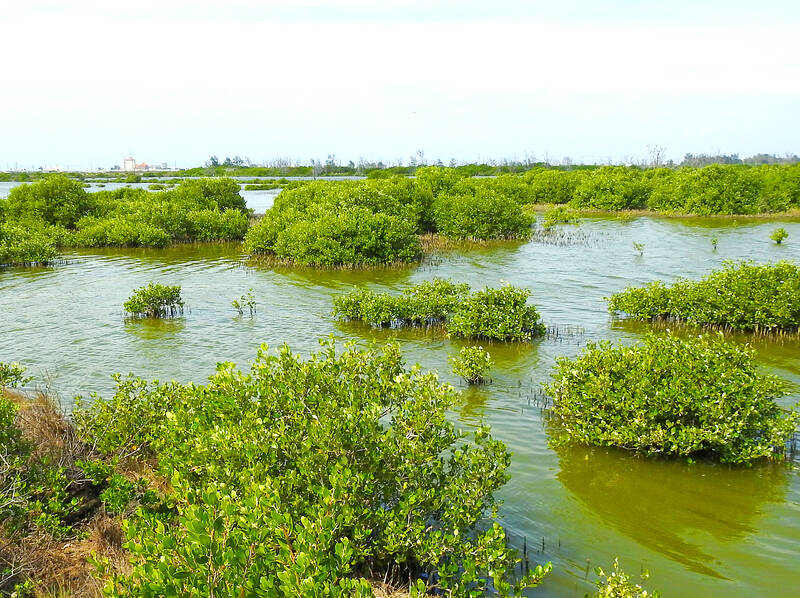
Photo: Steven Crook
According to UNESCO, the Earth is losing mangrove forests at a rate three to five times faster than that for other types of woodland. Taiwan is an exception to this trend, however — and a recent proposal might lead to a further expansion of mangrove coverage around the country.
On April 16, the Ministry of the Environment’s Climate Change Administration (CCA) published draft rules that would allow enterprises to acquire carbon credits by planting mangroves. On the same day, the CCA also issued draft regulations opening the door to seagrass restoration projects being a way to generate credits that can be traded or used to offset the sponsor’s own carbon emissions.
REFORESTING
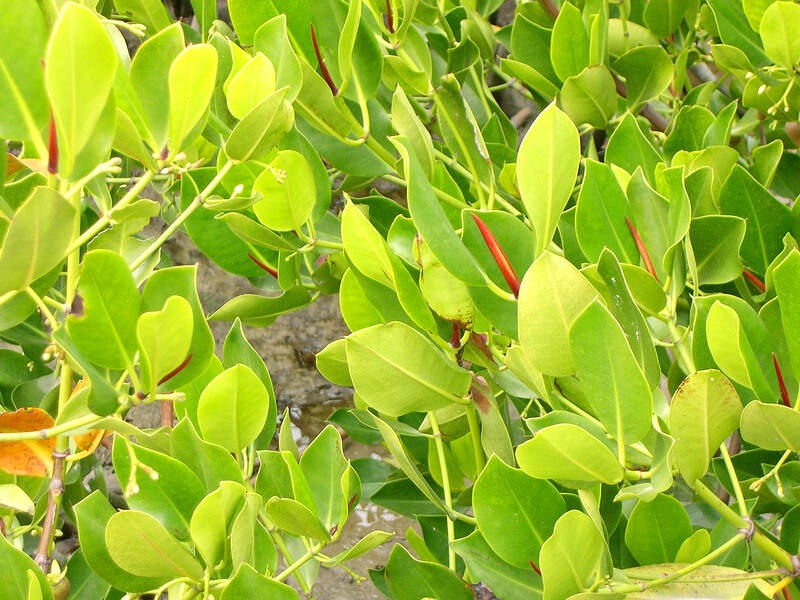
Photo: Steven Crook
Taiwan’s mangroves are doing much better now than they were a few decades ago.
Development and pollution in river estuaries and along the coast reduced the country’s mangrove forests to 178 hectares by 1976 and to as little as 120 hectares by 1985. The modernization and expansion of Kaohsiung’s harbor from the 1930s onward led to the disappearance of two of the six mangrove species then growing in Taiwan. (Around the world, there are at least 50 and perhaps as many as 80 types of mangrove.)
According to the Web site of the Ocean Affairs Council’s Ocean Conservation Administration (OCA), by 2019, mangrove coverage had rebounded to 680.7 hectares. A third of Taiwan’s mangrove forests are located in Tainan. New Taipei’s Luzhou District (蘆洲) is another place where growing environmental awareness appears to have helped mangrove ecosystems survive and expand.
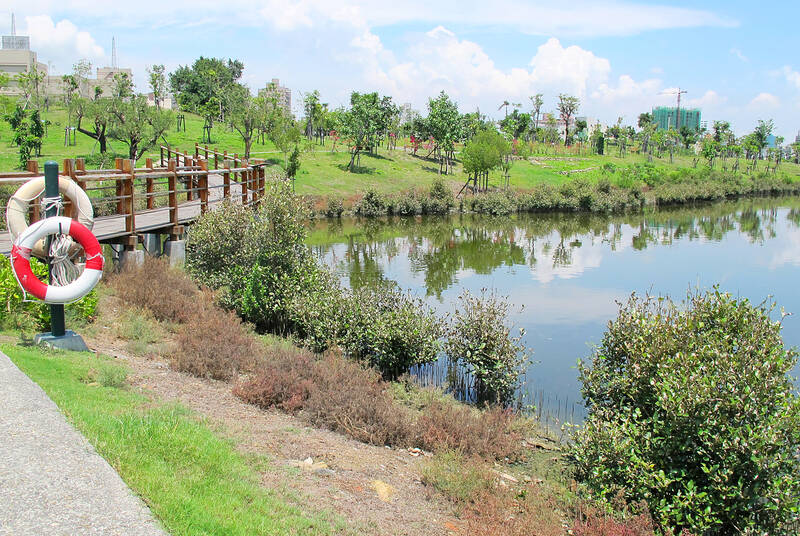
Photo: Steven Crook
Because some mangrove swamps store organic carbon up to three meters below the surface, the OCA estimates that the annual carbon absorption capacity of the country’s mangrove ecosystems is 4,486 times that of Taipei’s Daan Forest Park.
Much of the recent proliferation of mangroves is the result of human intervention. Writing in 2002, Fan Kuei-chu (范貴珠), an associate professor in the Department of Forestry, National Pingtung University of Science and Technology, noted that while several local governments launched mangrove restoration efforts in the late 1990s, “many projects failed because of unsuitable habitats and participants’ lack of basic knowledge and experience in mangrove restoration.”
However, Fan praised a 4.6-hectare project in Tainan that reintroduced Rhizophora stylosa (the red or stilted mangrove) and Lumnitzera racemosa (also known as the white-flowered black mangrove) to Anping Harbor (安平港).
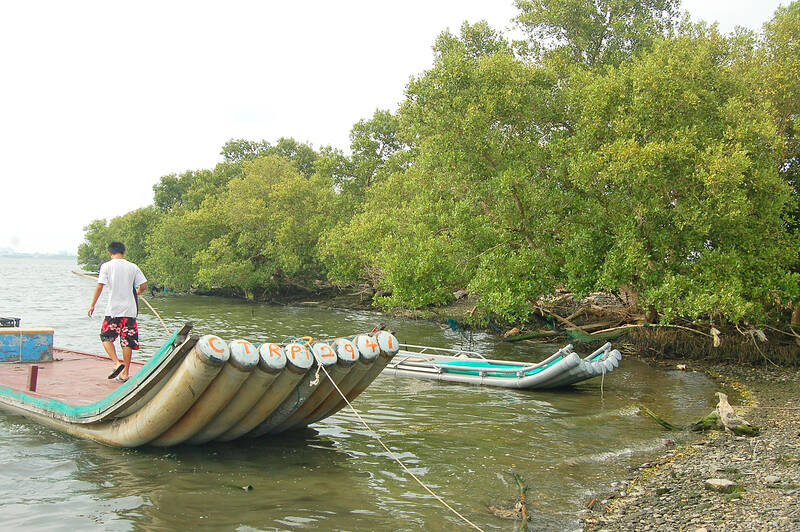
Photo: Yeh Yung-chien, Taipei Times
Since 2011, mangroves have been nurtured inside Jhongdu Wetlands Park (中都愛河濕地公園), next to the Love River in the center of Kaohsiung. The park — which was created by leveling shuttered factories and repurposing logging-industry pools — is about 4km from the river’s mouth, but near enough to the sea to be affected by rising and ebbing tides.
DRAWBACKS
In at least two places, successful mangrove-planting programs were curtailed or reversed because of negative impacts on other parts of the ecosystem (see “Whither Taiwan’s wetlands?” in the Jan. 27, 2021 issue of Taipei Times).
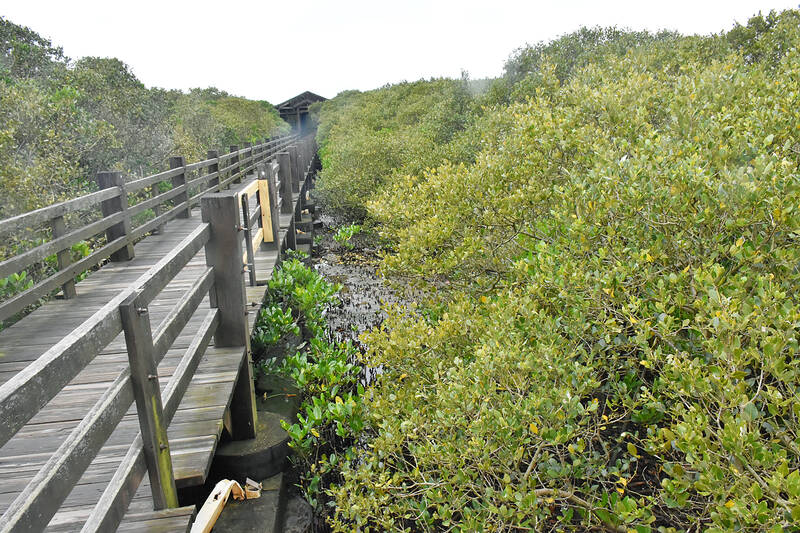
Photo: Liao Hsueh-ju, Taipei Times
Ground subsidence, caused by excessive pumping of groundwater, has harmed mangrove clusters in the counties of Changhua, Yunlin, Chiayi and Pingtung. These plants have evolved to survive being submerged in brackish water, yet they can’t stay healthy if their roots aren’t exposed to the air when the tide goes out.
Near-permanent immersion, because the land had sunk, is thought to be why many of the mangroves on the south bank of Chiayi’s Puzi River (朴子溪) died between 1986 and 1992. Parts of Taiwan’s west coast are continuing to subside. In a few places, the ground is sinking at a rate of more than 3cm per year; one reason, it seems, is the sheer weight of manmade infrastructure. On top of this, sea levels are slowly rising.
To maintain their preferred environmental conditions, such as frequency and depth of inundation, mangroves may respond to higher mean sea levels by retreating landward and colonizing new habitats. However, this is only possible where there’s an absence of seawalls and other obstacles, which certainly isn’t the case along much of Taiwan’s coastline.
A lack of sites suitable for afforestation isn’t the only reason why the CCA’s new rules might not lead to a significant proliferation of mangroves, say researchers quoted by Science Media Center Taiwan (台灣科技媒體中心).
In the May 1 online report, titled “Carbon Reduction Methodologies for Mangroves and Seagrass Beds: Expert Opinions,” Lin Hsing-juh (林幸助) — the National Chung Hsing University (NCHU) Department of Life Sciences professor who drafted the new rules — explains that, until recently, Taiwan’s carbon sink calculations didn’t consider the role of oceans and soil, but these categories can make “a significant contribution” to achieving the country’s emissions-reduction targets.
Lin argues that, if the draft methodology is approved, companies seeking carbon credits will invest in mangrove afforestation and seagrass bed restoration, bringing about “a win-win strategy of conserving biodiversity and increasing carbon sinks.”
However, he cautions that each location must be carefully evaluated, and that habitats where mangroves or seagrass previously grew should be selected. Because mangroves grow fast and may impact surrounding ecosystems, close monitoring and careful management will be essential.
Professor Shih Hsi-te (施習德), one of Lin’s colleagues at NCHU, expresses concern that new mangrove swamps could impede drainage and result in landowners suffering flood damage. What’s more, because the carbon storage capacity of mangrove biomes isn’t necessarily greater than that of other coastal wetlands, he says the authorities should integrate the opinions of ecologists, hydrologists and others, “to avoid causing further irreversible damage” to the environment.
Hsieh Cheng-i (謝正義), an associate professor in National Taiwan University’s (NTU) Department of Bioenvironmental Systems Engineering, points out that the carbon sink capacity of Taiwan’s existing mangrove and seagrass ecosystems is approximately 86,000 metric tons per year, a mere “drop in the bucket” compared to the country’s annual greenhouse gas emissions of around 297 million metric tons of carbon dioxide equivalent.
Nonetheless, any effort to reduce global warming deserves our attention, he says, adding that, while mangrove afforestation and seagrass bed restoration can only offset a tiny proportion of Taiwan’s carbon emissions, such actions may also protect certain habitats and prevent coastal erosion.
Ensuring that mangrove or seagrass projects don’t become examples of “greenwashing” will require accurate scientific measurement, says Shiau Yo-jin (蕭友晉), an assistant professor in NTU’s Department of Bioenvironmental Systems Engineering. Such efforts might have another benefit, he adds: They’re likely to help the public understand the importance of conservation and sustainability, and help protect the environment.
Skeptics have asked if allowing private enterprises to sponsor mangrove afforestation and seagrass bed restoration might lead to de facto private ownership of state-owned land along the coast. Others are wondering if clearing the way for such initiatives might make it easier for polluters to evade their overarching responsibility to reduce emissions. That, of course, must be a consideration when devising or proposing any type of offset or carbon-trading scheme.
Steven Crook, the author or co-author of four books about Taiwan, has been following environmental issues since he arrived in the country in 1991. He drives a hybrid and carries his own chopsticks. The views expressed here are his own.

Last week saw the appearance of another odious screed full of lies from the People’s Republic of China (PRC) Ambassador to Australia, Xiao Qian (肖千), in the Financial Review, a major Australian paper. Xiao’s piece was presented without challenge or caveat. His “Seven truths on why Taiwan always will be China’s” presented a “greatest hits” of the litany of PRC falsehoods. This includes: Taiwan’s indigenous peoples were descended from the people of China 30,000 years ago; a “Chinese” imperial government administrated Taiwan in the 14th century; Koxinga, also known as Cheng Cheng-kung (鄭成功), “recovered” Taiwan for China; the Qing owned

In Taiwan’s politics the party chair is an extremely influential position. Typically this person is the presumed presidential candidate or serving president. In the last presidential election, two of the three candidates were also leaders of their party. Only one party chair race had been planned for this year, but with the Jan. 1 resignation by the currently indicted Ko Wen-je (柯文哲) of the Taiwan People’s Party (TPP) two parties are now in play. If a challenger to acting Chairman Huang Kuo-chang (黃國昌) appears we will examine that race in more depth. Currently their election is set for Feb. 15. EXTREMELY

Jan. 20 to Jan. 26 Taipei was in a jubilant, patriotic mood on the morning of Jan. 25, 1954. Flags hung outside shops and residences, people chanted anti-communist slogans and rousing music blared from loudspeakers. The occasion was the arrival of about 14,000 Chinese prisoners from the Korean War, who had elected to head to Taiwan instead of being repatriated to China. The majority landed in Keelung over three days and were paraded through the capital to great fanfare. Air Force planes dropped colorful flyers, one of which read, “You’re back, you’re finally back. You finally overcame the evil communist bandits and

They increasingly own everything from access to space to how we get news on Earth and now outgoing President Joe Biden warns America’s new breed of Donald Trump-allied oligarchs could gobble up US democracy itself. Biden used his farewell speech to the nation to deliver a shockingly dark message: that a nation which has always revered its entrepreneurs may now be at their mercy. “An oligarchy is taking shape in America of extreme wealth, power and influence that literally threatens our entire democracy, our basic rights and freedoms,” Biden said. He named no names, but his targets were clear: men like Elon Musk